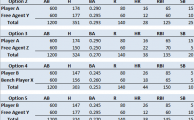I recently participated in a 2014 mock draft with representatives from BaseballProf.com, BaseballPress.com, FantasyBaseballCrackerJacks.com, and Razzball.com. Mock drafts at this point in the offseason are to be taken with a grain of salt (the draft was completed before the Fielder-Kinsler trade and before any free agency signings occurred). But it was a very interesting exercise in seeing how perceptions of players have changed after the 2013 season.
My First Round Pick Raised Some Eye Brows
I had the eighth pick. And as you can see from the results, the first six picks went as you might expect with names like Trout, Cabrera, Cano, and Goldschmidt.
Troy Tulowitzki was picked seventh, right before me (this is important, remember this).
Then it came to me and I was faced with a very difficult decision. As a subscriber to the belief that, “You can’t win the league with your first pick, but you can lose it”, I typically preach being conservative in the first round. But there was nothing “conservative” about the batch of players sitting before me:
- Ryan Braun (PED risk)
- Joey Votto (unspectacular of late)
- Adam Jones (can’t argue with the production, but plate discipline bothers me)
- Chris Davis (.240 batting average risk?)
- Clayton Kershaw (too early for me at eight)
So I chose Hanley Ramirez.
The Response
To say the pick has been questioned by some is a bit of an understatement. I was called out, labelled a masochist, and called crazy (30:40 mark).
Granted, I think these things were all said in jest. But I don’t think any other pick in the draft earned comments like these.
I Don’t Get It
I completely understand this being considered risky. And I can buy into the argument that eighth is too early. But let’s put that aside for now and debate something that I think is being overlooked.
I am surprised that nobody questioned the pick of Troy Tulowitzki just one pick earlier! I think Hanley Ramirez is the number one shortstop for the 2014 season. Not Tulo.
Let’s go through the possible counterarguments.
Hanley Ramirez is Injury Prone
May I present to you games played, by season, for Tulowitzki and Ramirez:
| Season | Tulowitzki | Ramirez |
|---|---|---|
| 2006 | n/a* | 158 |
| 2007 | 155 | 154 |
| 2008 | 101 | 153 |
| 2009 | 151 | 151 |
| 2010 | 122 | 142 |
| 2011 | 143 | 92 |
| 2012 | 47 | 157 |
| 2013 | 126 | 86 |
| Average | 120.7 | 136.6 |
*This was Tulowitzki’s rookie year. He did play in 25 MLB games, but I exclude it from the average because he didn’t play a full year and it was not due to injury.
There’s a perception out there that Hanley Ramirez is injury prone. That should be revised to state that he has experienced significant injury problems in two of the last three years. He’s been dependable the rest of his career. And much more dependable than Tulowitzki.
Tulo has only surpassed the 140 games played threshold three times in seven years! That’s six out of eight for Hanley.
The two seasons Ramirez did not reach the 140 game mark were due to shoulder surgery and a thumb ligament injury. I have nothing to back this up, but those don’t indicate “injury prone” to me, whereas Tulowitzki’s leg injuries do earn him the “injury prone” label in my mind.
Hanley Ramirez Is Getting Old.
He’s currently 29 and will be 30 during the 2014 season. Tulowitzki is only 10 months younger.







